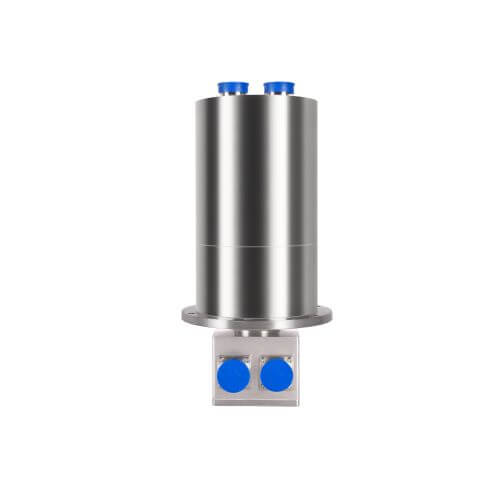In a world dependent on rapidly advancing technology, the safety and efficacy of our engineering systems have become paramount. A part of this pursuit of safety involves designing devices that can not only function optimally in extreme conditions but also mitigate risks associated with those conditions. One such device that stands as a testament to this evolution in design and safety is the explosion-proof slip ring.
These crucial components are designed to maintain electrical connectivity in systems with rotating parts, even in the face of potential flammable or explosive hazards. Essentially, they carry electrical power and signals from a stationary structure to a rotating one in environments known for high risk. The edge of these slip rings lies in their ability to prevent any sparks, arcs, or high temperatures, that could potentially ignite the surrounding potentially explosive gases or materials. This contributes significantly to maintaining safety in high-risk operational environments.
This guide is designed to delve more into the realm of explosion-proof slip rings, providing an in-depth understanding of their working principles, diverse applications, key features, and considerations in selection, installation, and maintenance. Regardless of whether you are a novice trying to grasp the basics or an expert seeking depth, this guide is set to cater to your informational requirements, offering a comprehensive overview of explosion-proof slip rings.
What are Explosion-Proof Slip Rings?
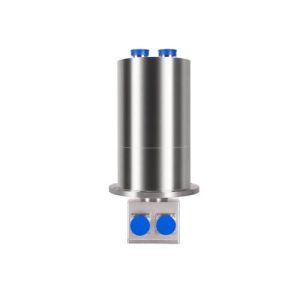
Explosion-proof slip rings are specifically engineered to provide safe and continuous electrical connectivity in systems that function in potentially explosive or hazardous conditions. Given their critical role, the design and construction of explosion-proof slip rings merit careful attention.
At their core, these slip rings are electromechanical devices. This means they function as conduits for electrical power and signals, bridging the gap between a system’s stationary components and those in rotation. However, unlike their conventional counterparts, explosion-proof slip rings have an additional layer of safety built into their construct. They are designed to contain and eliminate the risk of any internal sparks, arcs, or significant heat that could ignite the volatile atmosphere within which they operate.
The physical design of explosion-proof slip rings often involves rigorous encapsulation or isolation techniques to ensure any ignition risks remain confined within the device, thereby protecting the external environment from potential explosions. Materials used in their construction are carefully chosen for their qualities of durability, heat resistance, and capability to withstand harsh operating conditions.
The utility of these devices can also be linked directly to the environment they operate in. As their name suggests, explosion-proof slip rings are employed in environments characterized by potential explosive or flammable hazards. These could be spaces filled with combustible dust, environments laden with explosive gases, or areas where flammable liquids are in play.
In short, an explosion-proof slip ring acts as the protective, conductive link within rotational systems deployed in hazardous settings. Their design is a blend of comprehensive engineering, stringent safety norms, and practical utility, all converging to create a device that safeguards operations and, simultaneously, ensures the continuous flow of power and signals.
Explosion-Proof Slip Rings: How They Work
The working principle of explosion-proof slip rings forms the basis for their safety and efficiency in high-risk environments. In essence, these devices operate by facilitating the transmission of electrical power and signals from a stationary component to a rotating one. However, the distinct aspects lie in their design and construction, which avert potential ignition points and ensure safety even in volatile settings.
Explosion-proof slip rings consist of several essential parts: exterior housing, rotating and stationary contacts also known as brushes and rings, insulation materials, and connecting lines. Each part serves a specific purpose and plays a critical role in the overall operation of the device.
One of the slip ring’s essential components is the exterior housing, designed to contain any potential sparks, arcs, or hot surfaces produced due to electrical contact loss. The exterior housing is commonly made up of materials like aluminum or stainless steel that can withstand high pressures, ensuring that any internal sparks or arcs won’t escape and ignite the surrounding explosive environment.
At their core, explosion-proof slip rings operate on the principle of electromagnetic induction. The stationary brushes make contact with the rotating rings, transmitting electrical power or signals between them. These brushes and rings are designed and spaced in such a way that electrical contact is consistent, mitigating the possibility of sparking due to contact loss.
Combined with the robust exterior, the insulating materials deployed in these slip rings are critical. These materials prevent short circuits, another potential source of sparks, ensuring the safe operation of the device.
In terms of their role in larger systems, explosion-proof slip rings are an indelible part of any electrical system functioning in hazardous environments. Typically, these slip rings are integrated with rotating machinery or equipment employed in industries like oil, gas, mining, petrochemicals, and more. They transmit power and signals to the rotating parts, which would be impossible without a bridge like the slip ring.
In conclusion, the operation of explosion-proof slip rings hinges on a delicate balance of rigorous design principles, stringent safety precautions, meticulous construction, and their strategic positioning within the larger system. All these factors work together to maintain a constant, safe transmission of power and signals in potentially high-risk environments.
Explosion-Proof Slip Rings: Applications
Explosion-proof slip rings find applications wherever there is a need to ensure continuous electrical connections in moving parts while mitigating the risks of igniting potentially hazardous substances. In such environments, these slip rings play a pivotal role in guaranteeing safety and sustaining optimal operations. They are indispensable in multiple sectors due to their ability to prevent explosions in environments laden with combustible gases, flammable liquids, or even volatile dust.
Oil and Gas Industry
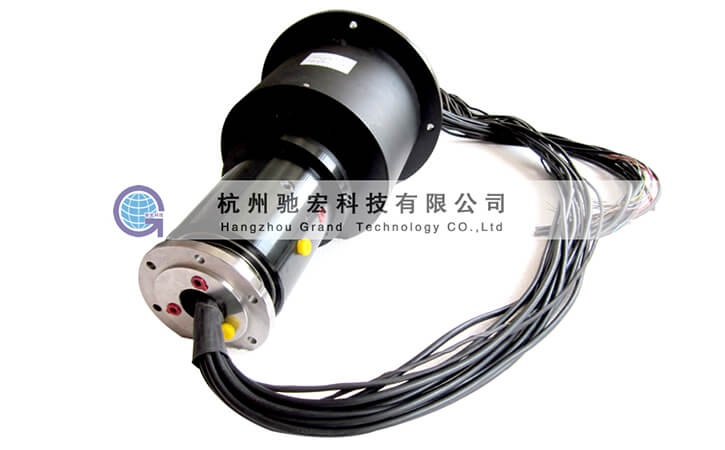
One of the chief users of explosion-proof slip rings is the oil and gas industry. It is an inherently hazardous sector due to the persistent presence of volatile gases and flammable materials during exploration, drilling, production, and refining processes. Slip rings in this industry help drive rotary tables, top drives, draw works, and other essential components of drilling rigs, maintaining safe and continuous power and signal transmission.
Mining Industry
Mining operations imply working in potentially explosive environments, particularly due to the presence of methane pockets or coal dust. Methane is a highly volatile gas trapped within coal seams, while coal dust itself is a significant explosion risk. Explosion-proof slip rings in this sector contribute to the operations of drilling machines, excavation equipment, conveyors, and other rotating machinery.
Chemical Processing Industry
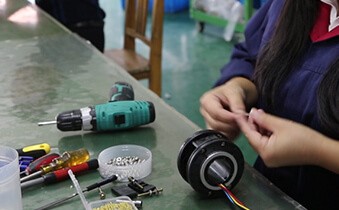
Chemical plants often deal with combustible chemicals and substances that can cause catastrophic consequences upon ignition. In such environments, explosion-proof slip rings are used in mixers, centrifuges, pumps, and other rotating equipment to ensure electrical integrity and prevent any internal ignition from impacting the hazardous environment.
Power Generation
In the power generation sector, there are risks associated with the ignition of flammable materials, like coal dust, in power plants. Explosion-proof slip rings are intrinsic to the safe and efficient operation of turbines, generators, and cooling systems, mitigating potential ignition risks.
Manufacturing and Other Sectors
The manufacturing sector and numerous other industries that deal with particulates, volatile solvents, and explosive dusts also feature explosion-proof slip rings. They help drive a plethora of rotating machinery and professional tools while maintaining a high degree of safety.
Maritime and Offshore Applications
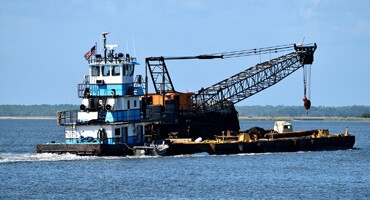
Maritime and offshore applications often involve potentially explosive environments, particularly in oil rigs or gas pipelines at sea. Here, explosion-proof slip rings are employed in crane operations, propulsion system management, and other seagoing equipment.
By designating safety and efficacy as central tenets, explosion-proof slip rings have successfully ingratiated themselves across diverse industries and innovative applications. These sectors understand the critical balance of maintaining non-stop, effective operations while ensuring the possibility of an explosion is kept at bay. And in this scenario, explosion-proof slip rings have proven to be an essential asset.
Explosion-Proof Slip Rings: Features
Explosion-proof slip rings boast a multitude of features innovatively designed to ensure their reliability and safety, showcasing the efficacy of the technology and materials used in their construction.
Safety and Compliance
One of the primary features of these slip rings is inherent safety. Their construction metes out robust enclosures, mostly made of materials like stainless steel or aluminum, capable of containing any ignitions within the device. This prevents the sparks, arcs, or raised temperatures from meeting the explosive atmosphere outside. To ensure their integrity, explosion-proof slip rings comply with globally recognized safety standards like ATEX, IECEx, and UL. This compliance serves as a testament to their commitment to operational safety.
Material Quality
Explosion-proof slip rings often deploy high-quality, durable and heat-resistant materials. These include gold-on-gold contacts, graphite, or precious metal brushes, which can withstand a broad range of operating conditions. The rigorous selection of these materials further augments the reliability and longevity of these slip rings.
Advanced Sealing Techniques
These slip rings employ advanced sealing techniques, enhancing their capabilities to work in extremely harsh conditions. They ensure an IP (Ingress Protection) rating of up to IP68, implying their resistance against dust, water, and other contaminants. This makes them viable for industries such as offshore drilling that often experience harsh environmental conditions.
Construction
The construction of explosion-proof slip rings also advocates meticulous engineering. Several design facets like specially designed raceways, precision ball bearings, and adequately spaced brushes and rings ensure smooth, low-friction operation with minimal electrical noise. This precision in construction aids in providing long service life and low maintenance requirements.
Customization Capabilities
Explosion-proof slip rings offer a high degree of customization as per various industry standards. They can be tailored to carry different types of signals (like data, video, and power) and be designed for specific power requirements or rotational speeds. This feature allows them to cater to the unique needs of various industries.
Compact and Modular Design
Despite their robust features, these slip rings often showcase compact, space-saving designs. They also offer modularity for easy integration into existing system designs, further enhancing their applicability.
These features collectively encapsulate the essence of explosion-proof slip rings— devices that can guarantee secure, reliable, and continuous power and signal transmission in potentially explosive environments. By leveraging cutting-edge technology and high-quality materials, these devices ensure that they can function optimally even under extreme conditions.
Explosion-Proof Slip Rings: Different Types
Explosion-proof slip rings are available in a diverse array of types based on their design, materials, and applications. Each type possesses distinct features that cater to various industries while ensuring safety and reliability in hazardous environments.
Through-Bore Explosion-Proof Slip Rings
These slip rings come with a hollow bore in the center, which allows the passage of wires or pneumatic/hydraulic lines. The through-bore design also contributes to easy integration with other machinery components. This type of slip ring is highly suitable for applications in industries like oil and gas, mining, and chemical processing, where the mounting space is limited.
Pancake Explosion-Proof Slip Rings

Pancake slip rings feature a flat profile, which allows for a compact design and easy integration into applications where space is at a premium. While their performance is similar to cylindrical slip rings, these designs require more specialized installations due to their relatively wider dimensions. Common applications include radar systems, satellite communication equipment, and wind turbines.
Capsule Explosion-Proof Slip Rings
Capsules or miniature explosion-proof slip rings are designed for low-profile installations requiring minimal space. They can transmit power and data signals while complying with safety standards and offering stable contact. These slip rings are mainly used in robotic systems, cameras, small medical devices, and other applications where space is limited.
Fiber Optic Explosion-Proof Slip Rings (FORJ)
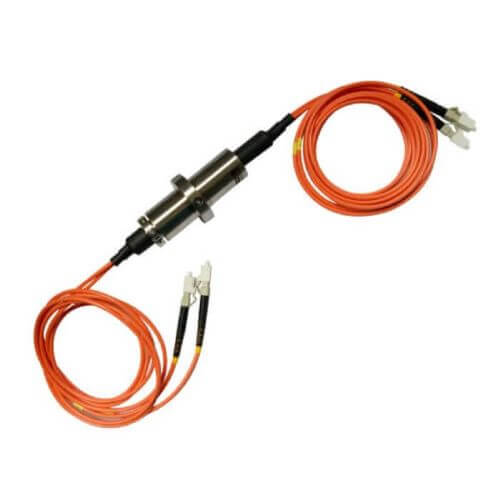
These slip rings incorporate fiber optic technology to transmit high-speed data signals in hazardous locations. Fiber Optic Rotary Joints (FORJ) provide immunity against electromagnetic interference and can handle large amounts of data transmission at high speeds. They are fully compliant with explosion-proof standards and are well-suited for applications in oil and gas, mining, and petrochemical industries.
Wireless Explosion-Proof Slip Rings
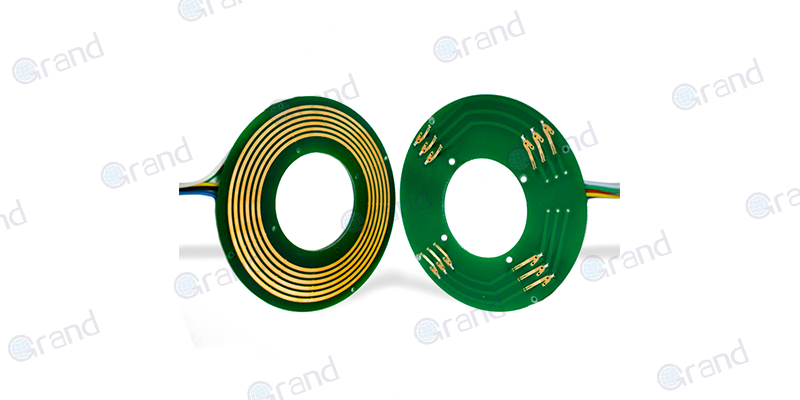
Wireless slip rings transmit electrical signals without direct physical contact, thus minimizing the risk of sparks generated due to contact loss. Utilizing advanced charging and induction technologies, they are ideal for applications where rotation is continuous and connector wear is a significant concern. Industries that benefit from this technology range from offshore platforms, oil rigs, and mining machinery.
High-Speed Explosion-Proof Slip Rings
Designed to ensure reliable performance at high rotational speeds, these slip rings are tailored to withstand demanding operating environments. Their precision-engineered parts reduce friction, thus enabling smoother rotation and reducing wear. High-speed explosion-proof slip rings find applications in wind turbines, flywheels, and other industrial equipment operating at high speeds.
In conclusion, explosion-proof slip rings are available in various forms, covering a wide array of applications, industries, and specific needs. By adapting their designs, materials, and technologies, they cater to different operational requirements while maintaining safety as their central tenet.
Explosion-Proof Slip Rings: Safety Standards
Explosion-proof slip rings must adhere to stringent safety standards to guarantee their ability to function safely in potentially explosive atmospheres. These standards often take the form of regional or international certification norms and ratings, designed to classify equipment based on its capacity to operate safely in hazardous conditions.
ATEX Certification – Europe
The ATEX certification, named after the French term “ATmosphère EXplosible,” is a stringent safety standard created by the European Union. This certification indicates that the equipment, including explosion-proof slip rings, is safe to use in potentially explosive environments. It is mandatory for all hazardous equipment marketed within the European Economic Area (EEA).
IECEx Certification – International
IECEx, administered by the International Electrotechnical Commission, is a global certification that ensures equipment safety in hazardous areas. According to this standard, explosion-proof slip rings should be built to prevent the ignition of potentially explosive gases or dust present in their operating environment. This system aids industries in declaring their equipment as safe for use in explosive atmospheres and is recognized worldwide.
UL Certification – United States
UL stands for Underwriters Laboratories, an organization that sets safety standards in the United States. UL-certified explosion-proof slip rings adhere to the safety measures dictated by the organization, implying their safe operation in hazardous environments. This certification is trusted across many industries and is seen as an authoritative validation of safety in the U.S. market.
NEC and CEC Ratings – North America
In North America, standards set by the National Electrical Code (NEC) in the United States and the Canadian Electrical Code (CEC) in Canada commonly govern explosion-proof equipment. The NEC and CEC ratings indicate the categories of hazardous environments where the equipment, including explosion-proof slip rings, can operate safely.
IP Rating – International
The IP (Ingress Protection) rating classifies the degrees of protection provided against intruding particles like dust, accidental contact, and water in electrical enclosures. An IP68 rating, often adopted by explosion-proof slip rings, means that they are dust-tight and can operate sustainably even when immersed in water.
Adherence to these safety standards and certifications plays a pivotal role in assuring end-users of the explosion-proof slip rings’ safety, performance, quality, and reliability. They guarantee that these slip rings can function optimally within potential explosion-prone environments, thereby instilling confidence in industries that prioritize safety.
Explosion-Proof Slip Rings: Installation and Maintenance
Proper installation and maintenance of explosion-proof slip rings are crucial in ensuring their safety, longevity, and reliability in hazardous environments. The following guidelines will provide a general overview to help with their successful installation and upkeep.
Installation
- Select the Proper Slip Ring: Start by choosing a suitable explosion-proof slip ring that meets the application requirements, adheres to the relevant safety standards, and matches the electrical and environmental specifications of the operating environment.
- Follow Manufacturer’s Instructions: Carefully read and follow the manufacturer’s installation manual and safety guidelines, as these provide precise instructions tailored to the specific design and model of the slip ring.
- Prepare the Workspace: Make sure the installation area is clean, well-lit, and dust-free. If necessary, de-energize the system to avoid accidental electrical discharge or sparking during installation.
- Ensure Proper Mounting: Mount the slip ring using the recommended hardware and method provided by the manufacturer to avoid loose connections, misalignments, or any other physical damage.
- Wire Connections: Attach electrical wires according to the labeling and wiring diagrams provided in the manufacturer’s manual, ensuring proper cable management and strain relief.
- Testing and Inspection: After the installation is complete, perform a test run to check for smooth rotation, proper signal transmission, and any potential issues. Inspect the slip ring for any irregularities, such as excessive noise or overheating.
Maintenance
- Scheduled Inspections: Regularly inspect the slip ring’s components for wear, corrosion, or other signs of damage. This helps identify potential issues early, allowing for timely repairs and minimizing downtime.
- Clean Contacts: Periodically clean the slip ring’s contact surfaces, ensuring they remain dust-free. Use a non-abrasive brush or cloth and a suitable cleaning solution recommended by the manufacturer.
- Lubrication: Slip rings with ball bearings may require periodic lubrication, as per the manufacturer’s guidelines. Use lubricants specifically recommended by the manufacturer to avoid compatibility issues or damage to the components.
- Monitor Environmental Conditions: Continuously monitor the surrounding temperature, humidity, and the presence of contaminants, ensuring the slip ring remains within its specified operating range.
- Follow Maintenance Schedules: Establish and adhere to preventive maintenance schedules as recommended by the manufacturer. This may include replacing worn brushes, inspecting seals, and testing electrical connections to maintain consistent performance.
- Professional Assistance: In case of any technical difficulties or uncertainty regarding maintenance procedures, consult the manufacturer or a qualified technician to avoid potential damage to the slip ring and any associated equipment.
By adhering to these guidelines, users can ensure the safe and effective installation and maintenance of explosion-proof slip rings. Regular upkeep maximizes their longevity and reliability, ensuring uninterrupted power and signal transmission in hazardous environments. Always follow the specific instructions provided by the manufacturer, as these may vary based on the type and design of the explosion-proof slip ring.
Explosion-Proof Slip Rings: Manufacturer & Supplier Selection
Choosing a reliable manufacturer or supplier for explosion-proof slip rings is a critical step to ensure the quality, safety, and durability of the product. Determining the right partner involves considering aspects such as their industry reputation, product quality, certification, customer service, and after-sales support. Here are some key considerations:
Industry Reputation
A manufacturer’s or supplier’s reputation can serve as a significant indicator of their reliability and trustworthiness. Look for companies with a proven track record in the market. Consult industry peers, check customer reviews, and case studies to get a sense of their standing in the industry.
Quality and Compliance
Ensure that the manufacturer’s products are of high quality, reliable, and adhere to leading industry standards. Check if their products have the necessary safety certifications, such as ATEX, IECEx, UL, NEC/CEC, and IP ratings, which indicate the product’s suitability for use in hazardous environments.
Technical Expertise
Verify the manufacturer’s technical expertise and their ability to provide custom solutions catered to your application’s requirements. This can include specific design modifications, different types of slip rings, and custom signal integrations.
Customer Service
Good customer service is essential for prompt and efficient communication. Your supplier should be able to address your queries, provide technical assistance, and deliver production updates, all within a reasonable timeframe.
After-Sales Support
After-sales support, like installation guidance, troubleshooting, and maintenance assistance, is another critical factor when choosing a manufacturer or supplier. This ensures the longevity of your investment and helps avoid any prolonged system downtime.
Financial Stability
A company’s financial stability can affect its longevity and reliability. It’s an important factor to gauge the company’s ability to support your needs long-term and honor agreements, warranties, and guarantees.
Delivery Time
Fast, reliable delivery times are crucial to avoid holding up project timelines. Make sure the manufacturer or supplier is equipped with efficient logistics and supply chain capabilities to ensure timely product delivery.
In conclusion, selecting the right manufacturer or supplier of explosion-proof slip rings involves an assessment of the provider’s reputation, product quality, technical expertise, customer service, and after-sales support. By considering these aspects, you can create a relationship that ensures the quality, reliability, and longevity of the slip ring in your application.
Explosion-Proof Slip Rings: Case Studies
Effective case studies can shed light on the practical applications of explosion-proof slip rings, demonstrating their potential and importance in the field. These success stories offer real-world insights into their performance and efficacy, showing how they contribute to safe and efficient operations in potentially hazardous conditions.
Case Study 1: Oil and Gas Industries
A leading oil and gas company required explosion-proof slip rings for their drilling rigs, where they faced potentially explosive gases and harsh environmental conditions. They opted for a manufacturer that offered explosion-proof slip rings with ATEX and IECEx certifications. These slip rings were resilient to challenging conditions and provided safe, uninterrupted power and signal transmission, eliminating downtime and enhancing the productivity of the drilling operation. This successful implementation showcases the essential role of explosion-proof slip rings in hazardous conditions.
Case Study 2: Manufacturing Industry
In a manufacturing scenario, a factory dealing with explosive dust required explosion-proof slip rings for their rotating machinery. The selected manufacturer suggested slip rings with IP68 and UL certifications, promising dust-tight joint and durability under long-term immersion in water. Post-installation, the production efficiency improved, as the slip rings ensured a seamless data transfer and power supply to the rotating equipment without any spark-induced explosions. The case study underlines the significance of reliable explosion-proof slip rings in dust-prone environments.
Case Study 3: Marine Industry
A marine company required explosion-proof slip rings for their offshore wind turbines, which operate in highly corrosive and explosive environments. They selected a supplier providing corrosion-resistant, explosion-proof slip rings with NEC/CEC ratings and robust customer support. The installed slip rings performed better than traditional models under volatile weather conditions, leading to reduced maintenance costs and increased turbine efficiency. This case study highlights the importance of explosion-proof slip rings in guaranteeing safety and performance in corrosive conditions.
By sharing these success stories and practical applications, users can gain valuable insights into how these devices optimally perform under real-world conditions. Moreover, they demonstrate the importance of explosion-proof slip rings in promoting safety, reliability, and improved efficiency in a multitude of volatile environments.
Explosion-Proof Slip Rings: Future Trends
As industries evolve and technologies advance, explosion-proof slip rings play an increasingly vital role in the safe and effective operation of hazardous systems, while also adapting to changes. Here are some potential future trends and technologies related to explosion-proof slip rings to be aware of:
Wireless Technology
The development of advanced wireless communication technologies presents new opportunities for contactless transmission of power and data in hazardous environments. Wireless slip rings could significantly streamline maintenance, reduce wear, and increase reliability, eventually providing an alternative to conventional slip rings. However, it is crucial to ensure these wireless solutions comply with safety standards and do not interfere with existing systems or introduce new hazards.
Enhanced Materials
With the evolution of material science, new materials are likely to emerge, increasing the performance, durability, and safety of slip rings. These advancements may include improved conductive materials or coatings, providing better resistance to corrosion, wear, and electrical noise. As a result, explosion-proof slip rings could see extended lifespans in hazardous environments.
Integration of IoT
The Internet of Things (IoT) is revolutionizing industries, enabling better data collection, analysis, and real-time monitoring. The integration of IoT with explosion-proof slip rings will help engineers better understand their systems’ performance, receive proactive alerts on potential issues, and enhance predictive maintenance capabilities. This could lead to a reduction in downtime, costs, and the avoidance of catastrophic accidents.
Advanced Sealing Technologies
To ensure longevity and uninterrupted operation, explosion-proof slip rings often require protection from environmental factors such as dust, corrosion, and water. Continued advancements in sealing technologies will provide improved ingress protection ratings. As a result, these slip rings will be more resilient to challenging and harsh conditions in various industries.
Green Energy Applications
With the growing emphasis on renewable energy sources and their increased adoption, explosion-proof slip rings will play a crucial role in wind, solar, and other alternative energy systems requiring power transmission in hazardous or volatile environments. This leads to the development of specialized slip rings designed for extreme weather conditions or corrosive environments found in offshore wind farms or solar installations.
In conclusion, the future of explosion-proof slip rings is likely to be shaped by advancements in communication technology, material science, IoT integration, sealing abilities, and environmental adaptations to meet the needs of developing industries. Staying abreast of these trends will enable users to leverage the latest and most reliable technology solutions, ensuring safety, efficiency, and longevity in hazardous settings.
Conclusion
Explosion-proof slip rings, with their robust capabilities, play a crucial role in maintaining safe and reliable operations in hazardous environments. Those tools have made a significant impact across a spectrum of industries, from oil and gas to manufacturing, and demonstrate their importance with successful implementations highlighted by the case studies. The need for such slip rings is vital in preventing potential explosions while ensuring smooth and uninterrupted data, signal, and power transmission.
One key takeaway is the need for careful selection of explosion-proof slip rings. It’s critical to match the specifications and certifications with the intended use and deployment environment’s specific requirements. As detailed in the Frequently Asked Questions section, users need to consider various factors to determine the right product, including electrical and signal requirements, industry regulations, and environmental conditions.
Moreover, we emphasized the need for regular and proactive maintenance to uphold the reliability and longevity of these vital devices. Users should always follow the manufacturer’s maintenance recommendations for each particular slip ring model.
Looking towards the future, the trend analysis provides highly valuable insights. Noteworthy developments in areas like wireless technology, advanced materials, IoT, and improved sealing technologies point to the continued evolution of explosion-proof slip rings, which will offer enhanced performance and reliability.
In conclusion, explosion-proof slip rings are indispensable tools in maintaining safe operations across diverse industries where hazardous conditions exist. Whether you’re sourcing first-time or upgrading, we recommend vigilance in product selection, ensuring the choice of a reputable manufacturer or supplier, proper maintenance, and keeping in sync with upcoming technology trends. With careful planning and execution, these powerful devices can serve as vital components in your company’s safety-oriented infrastructure for years to come.
FAQs about Explosion-Proof Slip Rings
To help facilitate a better understanding of explosion-proof slip rings, we have compiled a list of frequently asked questions and provided concise answers.
Q1: How can I ensure the reliability of the manufacturer/supplier of explosion-proof slip rings?
A: To ensure a reliable supplier, consider their industry reputation, product quality and certifications, technical expertise, customer service quality, after-sales support, financial stability, and delivery times. Evaluate suppliers based on these criteria to establish a long-term partnership that benefits your project.
Q2: What are some applications of explosion-proof slip rings?
A: Explosion-proof slip rings are employed in various industries where there is a risk of a potential explosion. Common applications include oil and gas drilling rigs, chemical processing plants, paint-spray booths, grain storage facilities, mining equipment, and wind turbines.
Q3: What certifications should explosion-proof slip rings have?
A: Explosion-proof slip rings should comply with relevant safety standards and certifications, depending on their target markets and applications. Key certifications include ATEX (Europe), IECEx (International), UL (United States), NEC/CEC (North America), and IP ratings (Ingress Protection).
Q4: How do I choose the right explosion-proof slip ring for my application?
A: To select the appropriate explosion-proof slip ring, consider the following factors:
- Review the application requirements, such as electrical specifications (voltage, current), signal types, and the number of channels.
- Verify the explosion-proof certifications that match regional safety regulations and your industry requirements.
- Evaluate the environmental conditions, including temperature, humidity, and exposure to dust or water.
- Consult with the manufacturer or supplier to ensure the product meets your specific needs and can be customized if necessary.
Q5: How do I maintain explosion-proof slip rings?
A: For proper maintenance of explosion-proof slip rings, follow these general guidelines:
- Regularly inspect components for wear or damage and replace them as necessary.
- Clean the contact surfaces to ensure they remain dust-free.
- Lubricate the slip ring, if required by the manufacturer’s guidelines.
- Monitor the environmental conditions and ensure the slip ring operates within its specified range.
- Establish and follow a preventive maintenance schedule.
Always consult the manufacturer’s manual for specific maintenance instructions.
By addressing these frequently asked questions, users can obtain a well-rounded understanding of explosion-proof slip rings, their applications, certifications, maintenance, and the importance of selecting the right manufacturer or supplier.
See What We Can Do

